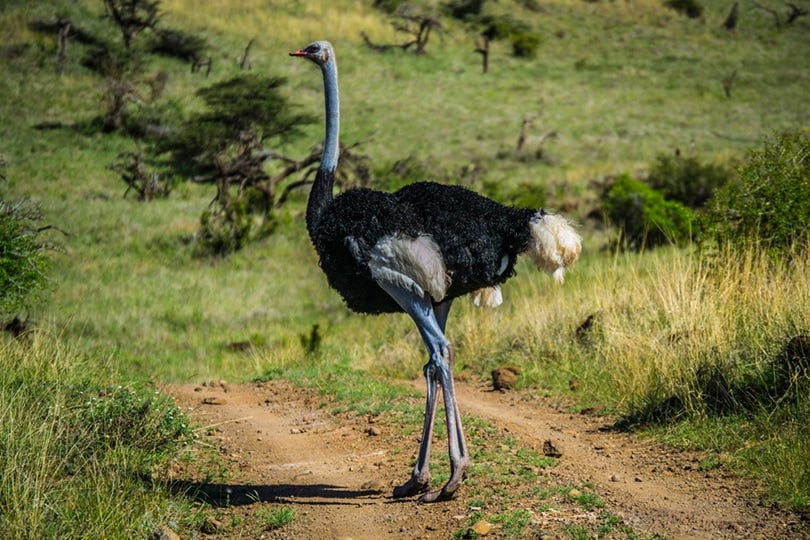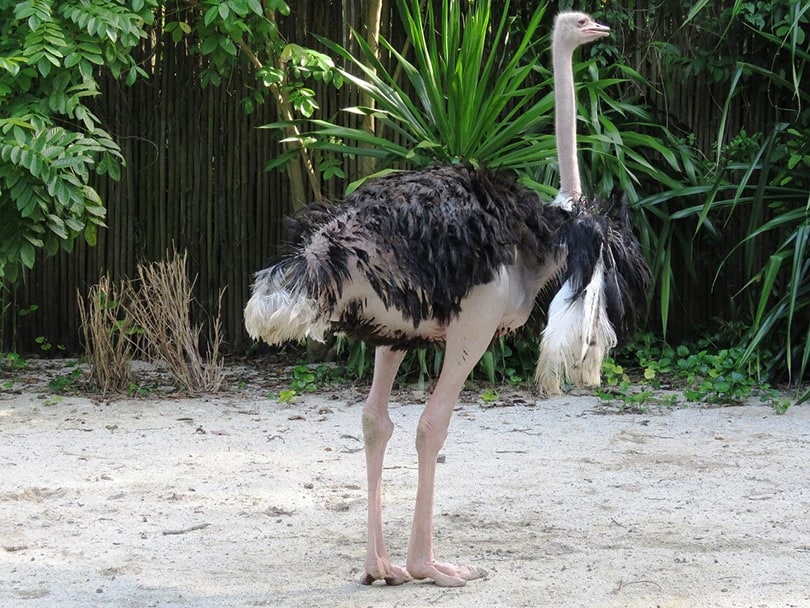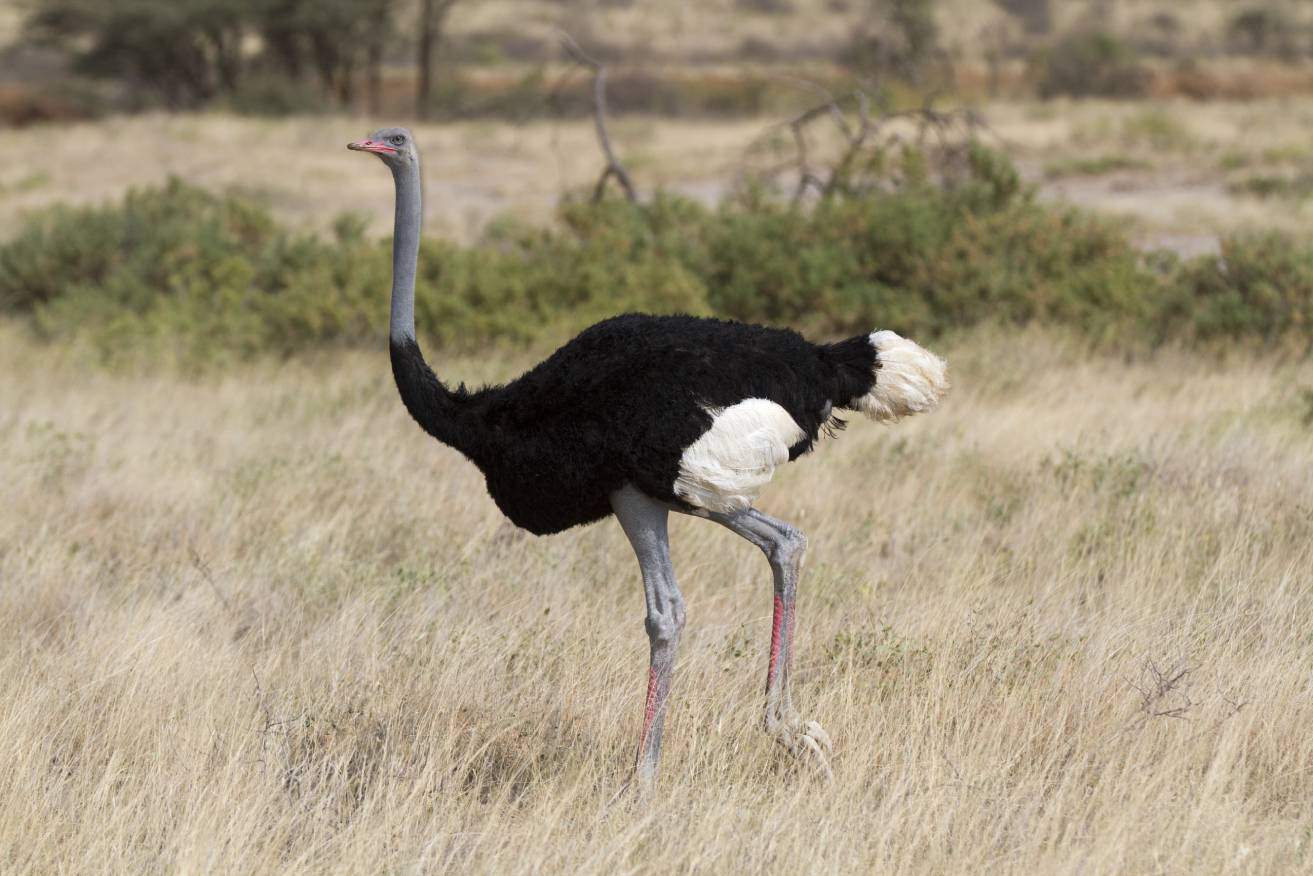Most people have heard of an ostrich before, but did you know that there are two different breeds of this massive bird? You might think of the common ostrich if asked to picture it; however, there is another kind that can be a vibrant blue if you catch them at the right time.
The Somali ostrich is a beautiful and impressive animal. While very closely resembling its cousin, it bears a couple of unique characteristics that make the Somali ostrich all its own. Let’s look at some quick facts.

Quick Facts about the Somali Ostrich
| Breed Name: | Somali Ostrich |
| Place of Origin: | Africa |
| Uses: | Feathers, Meat |
| Rooster (Male) Size: | 82–108” |
| Hen (Female) Size: | 68–75” |
| Color: | Black feathers, white tail, with a white neck and legs that both go blue during mating season |
| Lifespan: | 40–45 years |
| Climate Tolerance: | Extremely tolerant of climate; easily adapts from equatorial to arctic |
| Care Level: | Specialized, but low maintenance |
| Production: | Feathers, Meat |
Somali Ostrich Origins
The Somali ostrich, also known as the blue-necked ostrich, is a member of a flightless family of bird species called ratites. Among their cousins in this family are emus, kiwis, and rheas, to name a few. Like all birds, these lineages are descendants of dinosaurs, which makes the true origins of the Somali ostrich prehistoric.
An interesting footnote here is that until 2016, people believed that the Somali ostrich was a subspecies of the common ostrich. That was the year that it was identified as a distinct species, though it is very similar in both temperament and appearances to its common cousins.


Somali Ostrich Characteristics
While the Somali ostrich exhibits similar characteristics to the common ostrich, there are a couple of subtle behavioral differences. They prefer thicker bush than their cousins. Where a common ostrich is an open plains runner, the Somali loves to hide out in thick vegetation.
Other than that, ostriches, in general, tend to be typical ostriches. They eat a diet of mostly vegetation but have no qualms about snatching up a lizard, snake, rodent, or insect. This gives them the classification as an omnivore.
They can be quite aggressive and have powerful legs that can deliver devastating kicks. They travel in herds, and while you wouldn’t want to run into a wild herd of ostrich, as livestock they tend to be quite easy to care for. Ostriches are capable of being friendly, like any animal, but their pecks aren’t exactly the most pleasant form of affection you could receive.
Uses
If Somali ostriches hadn’t already been farmed for their meat and feathers at the time, it’s speculated that they would have been hunted to extinction in the 1800s. They are not only both hunted and farmed for their feathers—which are used in fashion, but their meat and eggs are also commonly harvested for cooking.
Appearance & Varieties
Where the common ostrich can be black or brown, the Somali ostrich usually features black primary feathers and white tail feathers. What makes a Somali ostrich unique is a way that its neck and thighs light up a bright, vibrant blue during mating season.
The Somali ostrich also appears slightly different in physiology. Where the common ostrich stands up very straight and tall, the Somali ostrich is shaped a little more like a tea kettle.

Population, Distribution, & Habitat
While ostriches used to be found from Asia to the Arabian Peninsula, they are now limited to Africa alone. Somali ostriches live in the north, near the Horn of Africa. While they have been exported to farms all over the world, Somali ostrich populations have been in decline, though it is not considered to be an endangered species.
Is the Somali Ostrich Good for Small-Scale Farming?
There is certainly a market demand for ostrich products. It had seen a decades-long lull but in the past few years is making a comeback. As the birds are low maintenance and their products sell for a high price, they make ideal livestock for small-scale farming. Ostrich has become a very popular species for smaller farms in the past few years, and that is partially because they make ideal livestock.
Somali ostrich may not be as common as their cousins, but they can be found in smaller farms all over the world. The next time you see one that is bright blue, you’ll know why! With eggs that sell for a premium and as low maintenance, easy to care for herd, Somali ostrich is a great option of livestock for those who may be considering farming them.
Featured Image Credit: Papa Bravo, Shutterstock
